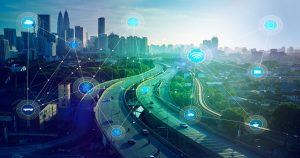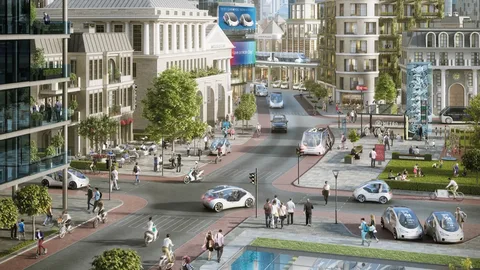In the last few years, the smart city concept has gained a foothold. Urban settings around the world are eager to exploit the use of technology and data to create conditions where the residents will have a good quality of life. The centerpiece of this revolution is big data, which is moving fast to change
In the last few years, the smart city concept has gained a foothold. Urban settings around the world are eager to exploit the use of technology and data to create conditions where the residents will have a good quality of life. The centerpiece of this revolution is big data, which is moving fast to change everything, such as cities’ ways of functioning, developing, and serving their citizens. This worksheet deals with the multilayered impact of big data in smart cities, touching on such matters as key applications, benefits, challenges, and future prospects.
The Evolution of Smart Cities

Image by Yandex.com
Smart cities indeed embody the nexus between city planning and cutting-edge technology. ICT (Information and Communication Technology), the Internet of Things (IoT) devices, and advanced data analytics support the efficiency of city operations and services in myriad ways. Smart cities development is forced by urbanization, energy, and sustainability challenges to think outside the box and use new technologies to solve problems efficiently.
As cities grow and expand, the amount of data they produce rises exponentially. This data is collected, analyzed, and utilized to advise urban planners, decision-makers and the public at large. Big data analytics is directing cities to deliver data-based decisions to solve challenging questions like resource allocation and enhancement of urban life quality.
The Evolution of Smart Cities
Smart cities are the culmination of urban pian and the state-of-art technology thus cities of such kind take in to use of Information and communication technology (ICT), Internet of Things (IoT) devices, and advanced data analytics to maximize the efficiency of their operations and services. The evolution of smart cities is triggered by the necessity of coping with challenges that are created by the fast growth of cities, limited resources, and demands for sustainable development. It is big data that fosters the multipronged development of smart cities which is the ground for big cities to have moving.
The emergence of big data and cloud computing has had a major impact on diligently optimizing urban resources from renewable energy to waste management. The evolution of architectures such as Smart Energy Grids, Smart Buildings and Homes, Smart Water Systems, etc has led to the phenomenon of Smart Cities as urban systems become interconnected, smarter, and more efficient.
Key Technologies Driving Smart City Initiatives
Some of the key technologies that are at the forefront of smart city development are mentioned in this section.
- Internet of Things (IoT): This is about the use of connected devices and sensors to the experienced world, thus, the cities’ development and tracking of different urban systems effectively are done by the cities only.
- 5G Networks: These networks are wireless telecommunication systems, and they have low latency, and they are therefore able to transmit data super fast and can as well support the growing number of the connected devices in smart cities.
- Artificial Intelligence (AI) and Machine Learning (ML): These are advanced algorithms that analyze a lot of data, such as those making predictions in urban management decision step.
- Cloud Computing: This technology allows for flexible, on-demand computing resources, which, in turn, permits the city to store, process, and analyze abundant data without the need for extentive on-site infrastructure.
Big Data Applications in Traffic Management
In urban areas, data use cases span quite a bit of ground, one of the important areas where big data is used comprehensively being traffic management. With the use of real-time data coming from different sources, such as sensors, cities can optimize transit, decrease congestion, and improve mobility.
Real-time Traffic Monitoring
Smart cities use a system of sensors, cameras, and GPS data fed from vehicles to fetch traffic state and conditions in real-time. This information is being examined to discover traffic jam events, accidents, or whatever else that could cause problems. It also affords the opportunity for the authorities to intervene in stoppages faster and more effectively.
Example: A big data solution provided by Transport for London (TfL) allows the city of London to monitor and manage its traffic network efficiently. The system, using CCTV cameras, traffic signals, and GPS buses, is able to adjust traffic signals according to traffic patterns, display the reality of travel times, and respond rapidly to incidents.
Adaptive Traffic Signal Control
Real-time traffic conditions and flow are among successful results of big data real-time applications, adaptive traffic signal systems being one of them, which adjusts signal light periods according to existing conditions, helping steer traffic smoother, reducing congestion.
Case Study: The city of Pittsburgh has Surtrac in place, which was developed by the scientists at Carnegie Mellon University. They used AI and real-time data to regulate the traffic signal timings, and the system brings about a 25% decrease in travel times, and 40% at intersections.
Smart Water Management

Image by Yandex.com
Information collected from big data analytics helps engineers improve the management of water distribution, identify pipes leaks, and enhance the general water supply system.
Example: Bangalore managed to cut down the water losses by 40% using a smart water management system that was implemented in the form of IoT sensors and big data analytics to detect leaks, assess water quality, and manage distribution. This led to the improvement in the overall water supply efficiency as well as a 40% reduction in water losses.
Urban Space Optimization
Through analytics of data on the population’s density, movement, and utilization of land, smart cities can more effectively re-design and allocate urban spaces to match their actual needs.
Example: The project Superblocks in Barcelona uses data analytics to develop the areas with the main focus on the pedestrians only and thus decrease automobile traffic. It has brought a 25% reduction in noise levels and has dramatically improved air quality in the areas where it is applied.
Citizen Engagement and Public Services
The potential data can empower cities to bring about better citizen engagement and deliver sophisticated and personalized public services is analyzed in this paragraph.
Digital Citizen Services
Smart cities utilize data analytics for the purpose of digitizing and personalizing the interaction of citizens with the city, so citizens can access more information from online resources, submit requests and communicate with local governments more easily.
Example: These Smart Government Services include the use of the digital ID which is secure and is applied by the citizens in over 99% of the public services that are on-line. There is also an overall reduction in bureaucracy, and it has been favorable to the city to improve public service efficiencies.
Participatory Budgeting
Such applications of big data analytics help cities progress by offering citizens the possibility to play very closely with city finances and to vote on budget allocations.
Case Study: Paris implemented a participatory budgeting program that allows citizens to propose and vote on projects to be funded by the city. This program utilizes a digital platform in order to collect and analyze data about the citizen’s preference making it to be an appopriate resource allocation based on citizens’ needs.
Open Data Initiatives
Many urban areas are practicing an open data initiative that exposes the government data to citizens, thus, allowing even more fruitful information sharing and promoting transparency.
Example: New York City’s Open Data portal is a platform that enables discovery of datasets from various city agencies that can be used by researchers, developers, and citizens to create urban solutions. These diverse data types are the very fabric of solutions that are only limited by the inventor’s imagination.
Challenges and Ethical Considerations
Big data creates an ideal ground for smart cities to flourish, but there are still some challenges and many ethical considerations that need to be solved first:
- Privacy Concerns: The accumulation and analysis of large-scale data raise privacy concerns among citizens. Cities must develop strong data security measures and make transparent the collection and use of data to protect the privacy of the citizens.
- Data Security: By them upgrading to smart cities, its defenses become thinner, which gives itself to cyber-attacks. Safeguarding the physical infrastructure and the database should be prioritized.
- Digital Divide: Another potential problem is that some people might easily miss sharing the benefits of the smart city projects thus further polarizing the society. Therefore, cities have to ensure that all the citizens possess the digital know-how to participate in the high tech quest for k
- Data Quality and Interoperability: The issues of the livelihood, precision, and interoperability of the data originate in the verity that the data come from different sources. Cities too have to channel resources to data management and to implement integration systems to ensure that their data is meaningful.
The Future of Smart Cities

Image by Yandex.com
With the rapid forward movement of technology, a bright future of smart cities is predicted:
- AI and Machine Learning Advancements: Further progress in AI and ML will allow cities to streamline the data processing since there will be more viable predictions and consequently, more rational decisions made.
- Expansion of IoT Ecosystems: Many more IoT devices are out there. These devices increase the amount of data we can get, the ways it can be analyzed, and the finer details we can control in urban networks.
- Increased Citizen Participation: The smart city environment will become more accessible to citizens when the city government decides to use the data from the smart city applications to improve the quality of urban life.
Conclusion
n conclusion, the evolution of smart cities lies in striking a balance between innovation and sustainability. By integrating cutting-edge technologies with environmentally conscious practices, these cities have the potential to redefine urban living. However, true progress demands a focus on inclusivity, ensuring equitable access to the benefits of smart city advancements. By prioritizing both technological innovation and sustainable development, cities can create dynamic, resilient spaces that meet the needs of today while safeguarding resources for future generations.






















